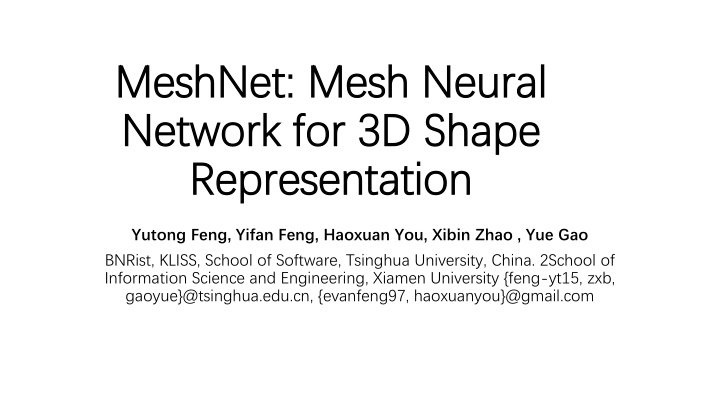
Advanced 3D Shape Representation using Mesh Neural Network
"Explore the Mesh Neural Network for 3D shape representation by Yutong Feng, Yifan Feng, Haoxuan You, Xibin Zhao, and Yue Gao. Discover the advantages of mesh data over other types like volumetric grid and point cloud, and the design ideas for organizing and transforming mesh data effectively."
Download Presentation

Please find below an Image/Link to download the presentation.
The content on the website is provided AS IS for your information and personal use only. It may not be sold, licensed, or shared on other websites without obtaining consent from the author. If you encounter any issues during the download, it is possible that the publisher has removed the file from their server.
You are allowed to download the files provided on this website for personal or commercial use, subject to the condition that they are used lawfully. All files are the property of their respective owners.
The content on the website is provided AS IS for your information and personal use only. It may not be sold, licensed, or shared on other websites without obtaining consent from the author.
E N D
Presentation Transcript
MeshNet MeshNet: Mesh Neural : Mesh Neural Network for 3D Shape Network for 3D Shape Representation Representation Yutong Feng, Yifan Feng, Haoxuan You, Xibin Zhao , Yue Gao BNRist, KLISS, School of Software, Tsinghua University, China. 2School of Information Science and Engineering, Xiamen University {feng-yt15, zxb, gaoyue}@tsinghua.edu.cn, {evanfeng97, haoxuanyou}@gmail.com
Why mesh Mesh data shows stronger ability to describe 3D shapes comparing with other popular types of data. Volumetric grid and multi-view avoid the irregularity of the native data but lose natural information. Point cloud has ambiguity caused by random sampling and the ambiguity is more obvious with fewer amount of points. However, mesh data is also more irregular and complex for the multiple compositions and varying numbers of elements.
Why mesh there is little effort on using mesh data in recent years, due to the complexity and irregularity of mesh data there are only early methods using handcraft features directly, such as the Spherical Harmonic descriptor (SPH) (Kazhdan, Funkhouser, and Rusinkiewicz 2003)
Design ideas Regard face as the unit. simplify the data organization make the connection relationship regular and easy to use Help to solve the disorder problem Split feature of face. for point need to know where you are for face want to know what you look like
Data transform Mesh data -> a list of faces; For each face Face Information: Center: coordinate of the center point Corner: vectors from the center point to three vertices Normal: the unit normal vector Neighbor Information: Neighbor Index: indexes of the connected faces (filled with the index of itself if the face connects with less than three faces)
Spatial descriptor Input center value Layers a shared MLP Output Initial spatial feature
Structural descriptor Input corner value normal values and neighbor Blocks face rotate convolution face kernel correlation Output Initial structural feature
Face rotate convolution 6 32 Input corner value Focus the inner structure of faces the shape information of faces 64 Output value ? , : kernels rotates through the face ? : an average pooling and MLP
Face kernel correlation Input normal values neighbors Focus the outer structure of faces the environments where faces locate
Face kernel correlation Output value KC i,k the k-th feature of the i-th face ?? the set of normals of the i-th face and its neighbor faces Mk the set of normals in the k-th kernel ?? , the kernel function indicating the affinity between two vectors more similar pairs will get higher values the parameters of kernels are learnable, they will turn to some common distributions on the surfaces of 3D shapes and be able to describe the local structures of faces
Mesh Convolution Input Initial spatial feature Initial structural feature neighbor Blocks combination of spatial and structural features aggregation of structural feature Output new spatial and structural feature
Combination Input Initial spatial feature Initial structural feature Method concatenates them together applies a MLP Output new spatial feature the combination result is actually more comprehensive the combination result contains both spatial and structural information concatenate all the combination results for generating global feature
Aggregation Input Initial structural feature neighbor Method 1. 2. 3. Average pooling Max pooling Concatenation Output Initial structural feature finally use the concatenation method in this paper
Experiments Classification, apply fully-connected layers (512, 256, 40) to the global features as the classifier, and add dropout layers with drop probability of 0.5 before the last two fully-connected layers. Retrieval, we calculate the L2 distances between the global features as similarities and evaluate the result with mean average precision (mAP). Training use the SGD optimizer for training, with initial learning rate 0.01, momentum 0.9, weight decay 0.0005 and batch size 64.
Feature Visualization Randomly choose several channels of these features, and for each channel, we paint faces with colors of different depth corresponding to their values in this channel. Blue features from face rotate convolution these faces with similar look are also colored similarly different channels may be activated by different types of triangular faces Red features from face kernel correlation faces in similar types of areas, such as flat surfaces and steep slopes, turn to have similar features, regardless of their own shapes and sizes.
